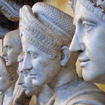Teaching Practice 7 - for TP 7b
A1 level
Description
Materials
Main Aims
-
To provide reading for gist and reading for detail practice using past simple text in the context of people who changed the world.
Subsidiary Aims
-
To provide the practice of producing writing in the context of your own past.
Procedure (39-55 minutes)
Tell the students they will see the pictures of three people. Put them into pairs and have them talk about who they are and what they did. Ask for the answers from each pair. Put the names of the people on the board. Ask, Are these important people? Then show a picture of Nelson Mandela. Ask students to discuss in pairs if they know who he is/what he did.
Show pictures on the board using the projector related to the vocabulary. Say a word and ask students to say which picture the word belongs to. Use CCQs to make sure meaning is understood, example sentences for form and pronunciation drills.
Put students in pairs. Tell them they will receive a piece of text but each paragraph is on a different piece of paper. Each pair must skim the text and make note of the dates in the text to put them in the correct order. Pairs will check with each other and CCQs will be used to confirm each pair got it correct.
Put questions on the board about the text using the OHP. Give the students 2 minutes to read the text and think about the questions. Then put the Ss into new pairs to talk about the questions with each other. Monitor to check for understanding. Then ask the questions as a whole class. Correct any mistakes and use CCQs to confirm understanding.
Tell the students they will work individually. Explain the T/F handout using chesting and model the first answer. Allow the students time to read both the text again and the true false statements on the handout to complete it. Have students check their answers in pairs. Then put a projection of the text on the board and have individual students highlight the text to show how they know whether each statement is true or false. Make sure each student does this for at least one questions. Go through their answers and correct mistakes using CCQs.
Show the students an example of a simpler text about a lifeline. Then ask the students to work individually and write their own lifeline from birth to now. All should be written in past tense. They can use the example on the board for reference. Monitor students and correct mistakes using CCQs.
Put students in new pairs. Tell students they will read each others writing and try to remember three things about it. Ask them to swap papers. After reading, ask the students to talk to their partner about the things they remember about their writing. Listen for mistakes and correct using CCQs. Move to groups or a mingling activity (depending on student numbers) to repeat what they remember. Monitor and listen for mistakes. Correct using CCQs.
Ask students to read the original text again and tell them to try to create a similar text together about Ataturk on the board. Correct any mistakes using CCQs.

